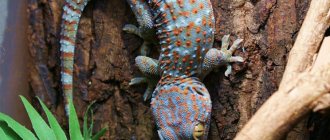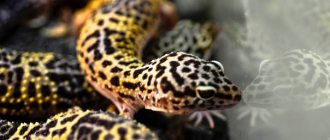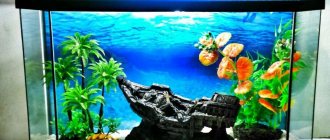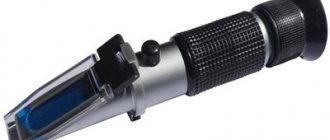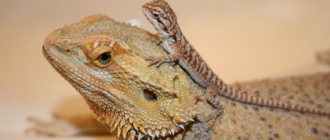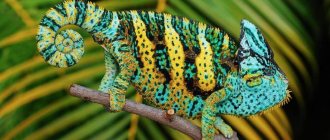Today, many families have exotic animals at home. Quite common inhabitants of home terrariums are lizards. They are unpretentious and do not require special conditions of maintenance, but still the owner will have to work a little on the proper arrangement of the terrarium, taking into account a number of important criteria.
In the article we will tell you what to pay attention to when choosing and arranging terrariums for lizards, how and from what you can make a terrarium with your own hands, where it is best to place it, and how to properly clean it.
Common lizard in nature
Such a reptile that lives on land is also called a “snatch”. This is an exotic pet. To ensure that keeping lizards at home does not cause any problems, you should become familiar with their natural habitat.
In the wild, the reptile prefers damp wetlands, mixed forests, conifers, steppe and forest-steppe zones. It is found in rocky, dry areas. Leads a terrestrial diurnal lifestyle, but easily climbs trees and rocky slopes.
Fast lizards do not move long distances from the territory they inhabit. They live in narrow burrows, digging them in the ground. The size of the sand lizard differs depending on the subspecies. The length with tail is 5-25 cm. Typically, males are larger and brighter in color than females.
The reptile has an interesting feature. If you grab the tail sharply, the lizard will attempt to bite or escape. The tail will remain in the hands of the offender. It will grow back soon, but will be shorter than before. This feature must be taken into account when planning to keep a reptile at home. Lizards live friendly with people. They get so used to their owner that they are not afraid to take food from his hands.
Terrarium care
For small lizards, moisture from plants and a bathing bath is enough, but especially large individuals can be released to swim in the bath, but first provide suitable support. Some species will need to have their rapidly growing nails trimmed regularly. Lizards require special attention during molting: for example, skinks shed their old skin completely, but others shed in parts. Remains of old skin must be removed by first soaking it in warm water. Many lizards do not like to be handled, so be sure to secure their front and back legs to avoid accidentally causing injury. You cannot grab a reptile by the tail or try to open its jaw yourself. Before picking up your pet, you need to wash your hands, and do the same after returning the lizard to the terrarium - it can be a carrier of diseases.
As for disinfection and cleaning of the terrarium, this should be done regularly: general cleaning at least once every 1-2 weeks, changing water and food every day.
Which terrarium to choose?
Lizards that exist in nature vary in species. Depending on this, the conditions for keeping them at home are different. A terrarium for land-dwelling lizards, such as the common lizard, should be horizontal.
When choosing its area and volume, the size of individuals and their number are taken into account. For example, for two ordinary lizards it is enough to equip a house measuring 60x40 cm. You can calculate the design parameters yourself. A terrarium for lizards should be twice the length of the animal in height, and one in width.
Reproduction
The male, who is ready to breed , looks around, raising his body above the ground. Seeing a female, he begins to pursue her. When he succeeds in catching it, he grabs it with his mouth near the base of the tail, clasps it with all his legs and mates.
After a certain time (usually the beginning of June), the female lays 7-15 fairly large eggs and buries them in a hole. The embryo inside the egg begins to develop, and a ready-made young lizard emerges (usually in August). Strong males can eat the young.
In the end, it is only necessary to note that, despite their exoticism, quick lizards are quite unpretentious animals. The most important thing is to initially create the “right” conditions for them. They are also smart and cute. Watching these animals is a pleasure for both adults and children.
Making a terrarium with your own hands
An aquarium can serve as a home for a pet. But you can do it yourself without much difficulty. The best material is organic glass. If the apartment contains a small lizard, the house for it is made without a frame. For a large individual, it is a frame structure. So, how to make a terrarium for a lizard? Below are the instructions:
- First the frame is made. It is easy to make by connecting the bottom and walls with silicone glue, which does not pose a danger to animals.
- Then you should start arranging ventilation. To do this, holes are drilled on one wall. You can make a wall out of wire. It will serve as a ventilation duct and active lizards can crawl along it.
- Next you should start making the bottom. For this, plywood made of several layers is better suited.
- The lid remains. It is better to make it from a fine metal mesh. Through it you can clearly see the interior of the terrarium, and most importantly, air circulates. You can make a composite cover. Its glass part is attached hermetically, and the wire part is folded back.
Nutrition
Spotted leopard geckos mainly feed on insects, small rodents and lizards, spiders and even their young. But the optimal food at home is small cockroaches and crickets. But there is no need to abuse such delicacies as zofobas and mealworms. This can lead to obesity of the animal and negatively affect its reproductive function. In the summer, good insect food options include:
- Locust.
- Grasshoppers.
- Green caterpillars of butterflies that are not covered with hairs.
But you need to keep in mind that insects can have worms, mites and other infections, so it is recommended to initially prevent various parasites.
Giving maggots is strictly prohibited, because of their external digestive system, which begins to digest the zublefar from the inside, as a result of which they can die. It is also not recommended to feed earthworms, as well as citrus products.
Approximate diet of leopard geckos:
- During the first few weeks, no more than two small crickets at a time.
- The older small generation up to three months - no more than three medium crickets per day.
- From three to six months - no more than five large crickets at a time and every other day.
- Up to a year - no more than six large crickets at a time and several times a week.
- Over a year old - no more than ten large crickets at one time and several times a week.
It should be remembered that you need to feed your reptile low-fat food based on the individual characteristics of the body, i.e. how much it will eat, the main thing is not to overfeed. And it is advisable to feed leopard geckos in the morning and evening, adding minerals and vitamins to its diet, otherwise without them it may simply die.
How to set up a terrarium for a lizard?
It is important to bring living in captivity closer to natural conditions. To do this, the bottom is covered with earth, which does not contain various additives and fertilizers. Sand, coconut shavings, and large pieces of bark are suitable as bedding.
A terrarium for a common lizard can be beautifully decorated with various elements that the reptile will definitely adapt for its life. These can be damasks with a rounded contour. The main thing is that the reptile does not get hurt. You can use plates and slides on which she will happily climb. For a lizard to live comfortably at home, it is important to maintain temperature, humidity, and lighting in a mode that best matches its natural habitat. In addition, you need to feed the reptile properly.
Geckos
Such reptiles are very famous for their love of climbing walls, no matter how smooth they are. This becomes possible due to the presence of a large number of microvilli and growths on their short limbs.
We invite you to familiarize yourself with the English Bulldog photo and description of the breed characteristics
Therefore, you should always keep nimble domestic lizards in sight, especially until the period of adaptation to the new environment ends.
The size of the reptile can vary from 1.5 to 35 centimeters. You can easily recognize a gecko by its appearance.
Such lizards have a flattened body, very small legs, a long thick tail and a disproportionately large head.
The second feature of this breed is the absence of eyelids on the eyes, therefore, in order to avoid drying out the eyes, the gecko has to lick them from time to time. These small reptiles live on average 15-20 years.
Plants
It is very important to observe the permissible combination of plants. Of course, any greenery can give a terrarium a natural look; with its help, humidity is maintained and the air becomes cleaner. But many indoor plants are not suitable for a lizard house.
Pets live according to their own schedule. They will dig soil in flower pots and make burrows. It is unacceptable to place plants in a terrarium for lizards whose stems are covered with thorns, thorns, piles, and whose leaves have jagged edges. Representatives of flora that differ in the content of toxic and sticky substances are not used.
To arrange the interior space of the terrarium, it is recommended to use bamboo, aucuba, indoor grapes, saxifrage, common ivy and others.
Plants are placed in a place inaccessible to reptile activity. For example, a container with them can be placed on a pyramid made of stones, hung from a lid, or completely isolated with a screen.
What health problems can a sand lizard have?
As a rule, there are two of them:
- Binge eating . Leads to diseases, decreased activity, problems with reproduction, and shortened life. Symptoms of overeating: the animal moves little and lies a lot, practically does not eat, the belly has enlarged, the lizard does not shed. You can't solve the problem without giving food. It is necessary to gradually reduce its amount, while increasing heating and daylight hours. All these measures are required to normalize the condition and speed up metabolic processes.
- Malnutrition . Without hibernation, fasting for 2-4 weeks is harmful. In this case, metabolism is disrupted, the body is depleted, color deteriorates, growth slows down, and problems with hibernation, molting and reproduction begin. You can recognize malnutrition by hanging skin, thinness, aggressiveness towards everything, rather reduced or, conversely, increased activity, and a shriveled tail.
Don't give these lizards a lot of food right away! You need to start with a few nutritious insects, gradually increasing the portion to normal. At the same time, increase humidity and heating, as well as daylight hours. You need to know that after a long fast, the process of digesting food takes twice as long as usual.
Recommendation: When you need to leave for several weeks and leave your animal at home, you need to turn off the lighting and lower the temperature in the terrarium to 14-19 degrees.
In this case, activity will remain, but metabolic processes will slow down, due to this, reserves of nutrients and energy will be consumed more slowly. Also don't forget to add water.
How to feed?
The lizard needs to be given food when it is in a state of activity. If there are several pets, each is fed separately. When the reptile is showing normal activity, drinking as usual, but eating little, there is no need to worry. She also has fasting days. Young lizards are fed using tweezers, while adults eat on their own from a plate. In summer, pets are fed 3 times a day, and in winter - only two. They feed on:
- spiders, worms, crickets, bird eggs, small mammals;
- for them you can prepare a special mixture of grated carrots and chopped meat into small pieces, taken in equal proportions;
- you can give cottage cheese, egg shells, calcium tablets, chalk (sources of calcium) and vitamins;
- it is allowed to eat salads, spinach, parsley, plantain, dandelion, clover;
- They like to feast on cabbage, cucumbers, zucchini, potatoes and fruits, for example, pears, apples, grapes.
Types of lizards: names and photos
The suborder of lizards is divided into six infraorders, including 37 families. We present one entertaining species from each infra-detachment.
- Iguanas. The most famous representative of iguanas is the Yemen chameleon. The species is distinguished by its large size among chameleons. Males reach a length of 60 cm. A characteristic feature of representatives of this family is the ability to mimicry. They change body color for camouflage purposes. The Yemen chameleon turns brown when threatened. However, do not expect bright colors from it - for such a spectacle you will have to take a closer look at other species.
- Skinks. The Crimean lizard is found in Moldova, Black Sea Russia (Republic of Crimea), the Balkan Peninsula and the Ionian Islands. It reaches twenty centimeters in length. The color is brown or green with dark rows of longitudinal spots. It has the ability to shed its tail and grow a new one, like all representatives of the True lizard family.
- Monitor lizards. In addition to the extinct marine predators of mosasaurs, the infraorder also includes the largest modern lizard - the Komodo dragon, which grows up to three meters in length and reaches a weight of more than 80 kg. At an early age they feed on eggs, birds, and small animals. Over time, they move on to larger prey. At one time, the Komodo dragon is able to eat an amount of meat equal to 80% of its own weight. Thanks to its elastic stomach and movable bone joints, this species swallows an animal the size of a goat whole.
- Gecko-like. The Madagascar day gecko or green felsuma is one of the largest representatives of its family. Individuals of this species reach a length of up to 30.5 cm. The color is bright green. They spend most of their life, not exceeding ten years, on trees in search of insects, fruits and flower nectar, which constitute the main diet of green felsum.
- Worm-shaped. Representatives of the vermiform infraorder bear little resemblance to lizards familiar to the average person. A typical representative - the American worm-like lizard - has no legs, no eyes, no ears. The animal does not even resemble a snake, but rather an earthworm, but they have no family ties with the latter. American worm-like lizards lead a burrowing lifestyle, representing another amazing branch of lizard evolution.
- Fusiform. Representatives of this infra-detachment also decided to give up their extra limbs. The brittle spindle, or copperhead, is often confused with the copperhead snake from the family Colubridae. This species of lizard is easily tamed by humans and lives in captivity twice as long as in nature, being protected from natural enemies.
Basilisk - an amazing lizard
This reptile has a crown-shaped crest on its head. The Basilisk lizard has an amazing feature: it runs on water at a distance of 300-400 m. But only young individuals whose weight does not exceed 50 g are endowed with this gift. Scientists conducted a lot of research before understanding how it manages to do this. It turns out that this phenomenon is accompanied by the structure of the paws and tail, low weight and speed. For this ability, the reptile was called the Jesus Christ lizard.
The reptile is an excellent swimmer. The Basilisk lizard can stay in the water for 2 hours and is able to move on its hind legs and climb trees. This nimble and fast reptile can run 10 km in an hour.
A characteristic feature of the lizard is its omnivorous nature. It feeds on insects, plants, berries, small rodents and lizards, as well as its own young. They produce offspring four times a year and live up to 10 years in a family of one male and several females. He is awake during the day and sleeps at night. When resting, they become easy prey for mammals, birds of prey and large snakes.
Habitats
In Russia, it is distributed north to South Karelia, the south of the Arkhangelsk region and the Komi Republic, the Khanty-Mansi Autonomous Okrug, South Evenkia, and Western Baikal region. Widely distributed in Europe from Southern England and Eastern France to the north of the Balkan Peninsula, in the Baltics, Belarus, Ukraine, Asia Minor, Georgia, Armenia, Western and Northern Azerbaijan, Northern Kazakhstan, south to the Northern Aral Sea region, Northern Balkhash region, the mountains of Eastern Kazakhstan; in Kyrgyzstan lives in the Issyk-Kul region, known from Northwestern Mongolia and Western China. The lizard lives in dry, sun-warmed places in the steppes, forests, and mountains up to an altitude of 1.5 km. The brownish and greenish-brown color hides it well among stones and grass. Lizards live in pairs, hiding at night in burrows, under stones, under the bark of stumps. Here they hide from autumn to winter.
Basilisk: keeping at home
This reptile is the most popular to keep in the house. It should be borne in mind that individuals taken from the wild do not take root well in an unnatural environment for them. Therefore, for home breeding and keeping, it is better to take lizards bred in an incubator. Living in a terrarium, the reptile's color changed. It turned bluish. The lizard will be sad alone. Therefore, these reptiles are kept in pairs.
Nutrition should be balanced. The basis of the diet is vegetation. Lizards eat sprouted wheat, carrots, bananas, apples and other fruits well. But they also need other food: small rodents, lizards. Animals lay their eggs in a nest, the bottom of which is covered with sand and wet moss. The eggs are taken from the female and raised for 30 days in an incubator.
Description
The sand lizard has a light underbelly and stripes on its back. Males are usually darker and more brightly colored, and their head, relative to the body, is larger than that of females; During the mating season they become brighter. There are several types of coloring: brown, green, gray. The lizards reach a length of 25 cm; there are individuals 35 cm long. During the mating season, males raise their heads and look around.
As a defense, these lizards drop their tail in case of danger. After which, within a few weeks (3-4), they grow a new one. But the spine that was in the old tail is replaced with cartilage. The tail can be thrown a huge number of times. Also, after discarding, it perfectly returns to its former appearance. The lizard is called a speedy lizard due to its ability to abruptly change the direction of movement in order to confuse its pursuer. This lizard is also capable of catching a fly in a jump, runs very quickly, and deftly climbs trees.
How to make the temperature 33 degrees in the terrarium?
Important: Temperature is one of the most important requirements for maintaining the microclimate in the terrarium.
Terrarium animals are very sensitive to temperature changes. All animals have their own biological needs for thermoregulation.
Various devices are used to maintain temperature:
- Heating lamps;
- Heated mats;
- Ceramic heaters;
- Infrared lamps.
- Heating thermal cords.
Warm areas are made for scaly ones. In these “sunny areas” the pets periodically bask. Then they crawl to places with lower temperatures. Heating lamps are suitable for this. They should be placed in such a way that the pet does not get burned from touching.
For snakes, heating mats are used under the ground; turtles are heated from above. To heat the snails, use a heating pad or rugs.
A budget-friendly heating method is to place the terrarium near heating radiators or heaters. But this method has a number of disadvantages that can affect the normal life cycle of animals. Still, it is better to use special devices for heating terrariums.
Important: You can and should monitor the temperature in the terrarium using a thermometer.
Sizes and shapes of terrariums
Science knows over 3.5 thousand species of lizards. Of course, not all species are kept at home. It is necessary to understand that for representatives of each species of lizards it is necessary to select a “dwelling” in accordance with the size of the animal. There are certain rules for selecting a terrarium for each specific type and size of scaly reptiles.
- For example, for tree lizards you need to build a “house” where the height of the walls will be equal to twice the length of the animal. Least.
- Approximately the same formula is suitable for land running lizards, but only the 1:2 ratio applies to width and length. In the sense that the length of the terrarium should be equal to twice the length of the pet, and the width should be equal to one length.
How to make and decorate an eternal mini-terrarium from a light bulb?
Terrariums made from light bulbs look original and stylish. The most common light bulbs of different sizes are suitable for making such a terrarium. To begin with, we recommend trying to work with the largest light bulb.
You will need:
- Large light bulb;
- Screwdriver;
- Round nose pliers;
- Scissors;
- Long tweezers.
Be sure to protect your eyes with goggles, as pieces of glass may fly off during operation.
Step-by-step production:
- Remove the metal seal on the light bulb base.
- Then use a screwdriver to very carefully break the internal parts of the light bulb.
- Using long tweezers, remove the “entrails”.
- Finish the hole well with a screwdriver so that there are no sharp edges.
- To stabilize the light bulb, make legs by adding 2-4 drops of silicone glue.
- Now pour sand and dry moss through the funnel and place the plants using long tweezers.
- You can use small pebbles and plastic figures as decoration.
- A mini-terrarium made from a light bulb can be placed on a stand. This will make it even more impressive.
Mini terrarium in a light bulb



